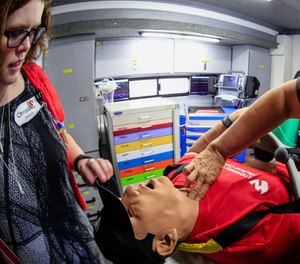What is Continuing Education Purpose in Ems
Break the mold with individualized CME prescriptions based on comprehensive individual educational needs assessments
By Mic Gunderson
Have you ever questioned why the continuing education classes given to EMS professionals at a given level of certification are pretty much the same regardless of an individual's knowledge or experience?
Why does an EMS professional at a busy station in a retirement community with a high volume of cardiac cases get the same CME classes as a paramedic in a rural system with low call volume but a high proportion of high-speed vehicular trauma?

Why does an EMS professional who reads, listens to and watches multiple EMS related trade and academic journals, blogs, podcasts and vlogs every month have the same CME classes as someone who doesn't engage in any CME activities between their certification cycles?
There are many one-size-fits-all approaches in various areas of healthcare, business and government. We see a lot of standard adult dose medications. We have standardization in most areas of education, including EMS training program curricula. These one-size-fits-all approaches are often the best approach when they meet a specific need efficiently and effectively. But that's not always the case.
EMS professionals may have attended the same or similar initial training programs, but their knowledge and skills levels are not frozen in time on their graduation days. Their knowledge and skills will vary considerably based on the types and frequencies of their clinical experiences and the roles they played on scene; as well as their efforts to study and practice throughout the year.
Yet despite these significant differences in experiences and study habits, EMS professionals usually end up in the same or similar types of continuing medical education programs – and that one-size-fits-all approach might not meet their needs as well as it should.
Prescribing the right continuing education
One of the objectives of a sound quality management program is to improve the design of an organization's processes to better meet the needs of those who depend on those processes. This example of using the same CME program for EMS professionals with significant experiential, knowledge or skills differences is a good example of where there's a gap between a once-size-fits-all process design and the diversity of needs among EMS professions for CME. So how might we change the design of the CME process to close that gap?
Think of CME like a prescription. Before writing a prescription, a physician assesses the patient, identifies clinical deficiencies and problems, and comes up with a treatment plan to address any problems and improve general health by addressing clinical deficiencies. For EMS, consider assessing an EMS professional's knowledge and skills across their entire scope of practice. Use the results of that assessment to identify any specific problem areas and identify their relative strengths and weaknesses. That becomes the basis for the CME prescription.
This idea assumes the availability of a comprehensive assessment process to measure EMS professional's knowledge and skills. This is not the same as an assessment used for certification purposes. A certification assessment seeks to determine if an individual is able to meet a minimum threshold. It is not there to measure the depth of their knowledge and skills like a comprehensive assessment would. A comprehensive assessment could also be used to track changes in knowledge and skills levels over time.
In some areas, the EMS professional's knowledge and skills may dramatically exceed the minimum standards. In such cases, their CME prescription may have them take an update class, but also have the option of opting out of refresher classes in favor of taking more advanced classes or offer wider latitude in taking CME elective classes based on their interests. If an individual needs refresher classes for a specific subject area, that can be addressed in the CME prescription while still letting them take more advanced classes in areas where they are stronger.
Individualized CME prescriptions based on a comprehensive individual educational needs assessment – this can be a powerful professional development strategy for EMS agencies ready to go above and beyond the standard cookie cutter approaches to CME.
Read next: Q&A: How to encourage employee growth and maintain high standards . Eve Grau, co-founder of Royal Ambulance, shares the company's philosophy for cultivating highly-motivated employees and how it positively impacts their agency.
About the author
Mic Gunderson is chief strategy officer and senior advisor, Cambridge Consulting Group.
About the author
The Cambridge Consulting Group is a group of independent consultants who have formed an unprecedented collaborative team of experts in the paramedicine field. The team has extensive knowledge and experience in emergency medical services, ambulance operations of every organizational structure and medical transportation service.
CCH works locally, regionally, at the state level, interstate level, federally and internationally to review your needs, identify the best team of advisors and engage in a unique mutually supportive, interdisciplinary approach to provide the best solutions for you.
Source: https://www.ems1.com/ems-products/education/articles/re-thinking-the-design-of-ems-continuing-education-programs-hH3eCsCdVfC739Xg/
0 Response to "What is Continuing Education Purpose in Ems"
Post a Comment